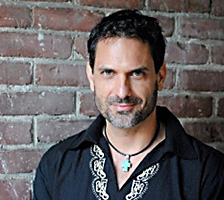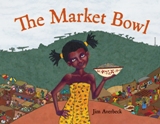Peace Corps Writers 2014 Award For Best Book for Children

Peace Corps Writers began presenting awards for Best Children’s Book in 2001.
•
CONGRATULATIONS to Jim Averbeck for winning the 2014 Peace Corps Writers Best Book for Children award for his charming story The Market Bowl that he both wrote and illustrated. The Market Bowl is set in Cameroon and was published in 2013. Jim will receive a small cash award, and a certificate.
Peace Corps Writers asked Jim a few questions about the Peace Corps, Cameroon, and writing books for children (and their parents) that he has agreed to share with us.
.Why the Peace Corps?
When I graduated from college I felt my life was becoming consumed with chasing money, instead of learning and growing. So when a friend jokingly told me I should join the Peace Corps, I explored the possibility. And the more I looked at it, the more I wanted to do it. It seemed like a good way to give back to the world for all the privileges I had been given. It turns out, though, as we all learned, that I received far more than I gave. It was a fantastic experience.
.
Where were you stationed?

photo of author Jim Averbeck by Sonya Sone
I was assigned by the Peace Corps to work on water and sanitation. I helped villages build spring boxes and wells to provide clean, uncontaminated drinking water for their populations. I worked on a project to build a small dam, which kept water from running off to the sea and forced it to recharge the groundwater. This made the wells in the area last longer into the dry season before they dried up. And I evaluated some possible water projects for the United Nations Guinea Worm Eradication Project. The work I did for them was fairly small, but one of my friends, Susan Graham, did a lot for them. Guinea worm is a fairly disgusting disease. You swallow the worm eggs by drinking contaminated water. About a year later, worms that are several feet long burrow their way out of your arms and legs. It is very painful and potentially crippling. At the time, the only way to remove the worm was to wrap it around a stick and pull it out of the body about one inch per day. Gross!
.
What was the food like?
I ate a lot of bitterleaf. It’s called ndolé in the French part of the country. It is difficult to make. The leaves need to be washed very well so they aren’t overwhelmingly bitter. All the Volunteers knew the best places near them to get the best bitterleaf, and which places to avoid.
Besides bitterleaf stew, children eat all kinds of fun things. There is a season of the year where they eat a sort of grasshopper. The kids gather around street lights and other light sources that attract the grasshoppers and catch them, then bring them home to fry up and eat. They must be quite good, though I imagine the legs might get stuck in your teeth.
Yum!
There was another dish which I loved, called folaré. It was also a leaf dish. The leaf was sour and served with a peanut sauce. I’ve looked for a similar leaf here in the states. The closest I have found is something called redwood sorrel. It tastes similar, but you can’t eat a lot of it, because it is slightly toxic and apparently a laxative! I also loved koki (a sort of yummy cake made from beans) and esankana (warm, roasted, spiced peanut butter.)
.
What languages did you speak in-counry?
During the three years I lived in Cameroon, I learned one of the indigenous languages, Bulu. I can still say a few things in Bulu, to the delight of a Cameroonian friend I met in California ten years after I got back. For example, you might say “Ye ô ne mvoe?” (pronounced a bit like “Oh Num Voy”) when you meet a friend on the street, to ask someone how they are.
I met my Cameroonian friend Nathalie after I came back to America, when I was the Regional Advisor for the Society of Children’s Book Writers and Illustrators. She emailed me and was surprised when I answered her in Bulu!
.
How did you come to write books for children?
When you go to live in a foreign country, where no one knows you and you know no one (at first), you get to find out a lot about who you are. Your identity is no longer defined by the expectations of friends and family who have known you forever. So I guess I was on the look out for new ways to express who I am. One night, as I listened to the music of the drums and the mbira (small finger pianos) being played at a party near my house, I fell into a sort of a trance. I had a dream that I thought would make a good picture book so when I got back to the states, I learned how to make that happen.
.
What are Cameroonian children like?
Cameroonian children have a broad range of experiences. Maybe this would be a good place to say that much of what we are shown here in the United States about the experience of African children is a bit uneven. We usually see images of poverty, famine, and misery. And while it is true that these all exist somewhere on the continent of Africa, it is only a small part of the story. Some Cameroonian children are quite wealthy, and have all the things that American children might have — x-boxes and bicycles and such. Others have very little, but find ways to play and have fun just the same. I’ve seen these kids make toy cars out of old water bottles, shoe soles and bamboo. One thing that Cameroonian kids don’t have (or at least they didn’t when I was there) is cable TV. They do have television, but there is only one station. So the kids spend a lot of time outdoors playing games they make up. A lot of Cameroonian kids also work, helping the family make money, like Yoyo in The Market Bowl.
Families are different in Cameroon too. It is legal there for a man to have more than one wife, so families may be very large. I stayed with one family that had one father, four mothers and 23 children. That’s a lot of brothers and sisters! In America we sometimes say “It takes a village to raise a child” but this expression comes from Africa. In Cameroon, all the adults in your village are considered your relatives. So if you have one father and three mothers, you may have dozens of aunts and uncles. That’s a lot of adults for a kid to answer to, isn’t it?
.
Review of The Market Bowl
The Market Bowl
(for children 5–8)
by Jim Averbeck (Cameroon 1990-94)
Charlesbridge
$16.95
32 pages
2013
Review by Thomas Weck (Ethiopia 1965–67)
•
The Market Bowl is a delightful story with an important message for young, impressionable minds.
Yoyo is an endearing young girl, but she has yet to learn the absolute necessity of honesty and fairness. By taking an ill-advised shortcut, she puts her whole family’s livelihood in danger. Through contrition, hard work and more than a little courage, in a drama filled scene, she is able to put things straight. She learns a lesson she will never forget.
The copious full-color illustrations add to the enjoyment and present another way of telling the story. In and of themselves, they help convey the different customs and lifestyles of the Douala peoples of the Cameroon. Extra features that add to the overall high quality of the book are
- at the the beginning, instructing the reader how to pronounce key words in the Cameroon culture;
- at the end, a concise description of the Cameroon complete with a map showing its location in Africa;
- also at the end, the extra bonus of the recipe for Bitterleaf Stew with careful consideration of suitable substitute ingredients when native ingredients may not be available.
Overall, this story is an excellent read, bedtime or anytime, that will surely be read more than once.
•
Reviewer Tom Weck and his son, Peter Weck, have written five children’s books for their “Lima Bear Stories” series, three of which were awarded the 2012 Peace Corps Writers Award for Best Children’s Book(s): The Megasaurus, How Back-Back Got His Name, and The Cave Monster.
As grandmother-in-training, knowing about this book in particular and all the Lima Bear Stories is just great! Thank you.